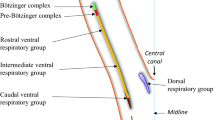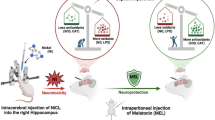Abstract
Ketamine (KET), an anesthetic, analgesic, and a sedative N-methyl-d-aspartate (NMDA) receptor antagonist agent, exposure during neonatal period may lead to learning impairment, behavioral abnormalities, and cognitive decline in the later years of life. In recent studies, it has been reported that sedative-acting α2 agonist dexmedetomidine (DEX), which is commonly used in clinical practice with KET, has neuroprotective effects and prevents the undesirable effects of anesthesia. To elucidate the underlying mechanisms of these actions, we investigated the interaction between NMDA receptors α2 adrenoceptor and adulthood behaviors in neonatally KET and/or DEX administrated mice. Balb/c male mice were administrated with saline, KET (75 mg/kg), DEX (10 µg/kg), or KET + DEX (75 mg/kg + 10 µg/kg) on postnatal day 7. During adulthood (8–10 weeks old) mice were subjected to elevated plus maze, open field, and Morris water maze tests. After behavioral tests, hippocampus samples were extracted for mRNA expression studies of NMDAR subunits (GluN1, GluN2A, and GluN2B) and α2 adrenoceptor subunits (α2A, α2B, and α2C) by real-time PCR. Ketamine increased horizontal and vertical locomotor activity (p < 0.01) and impaired spatial learning-memory (p < 0.05). DEX increased anxiety-like behavior (p < 0.01), but did not affect spatial learning-memory and locomotor activity. KET + DEX impaired spatial learning-memory (p < 0.01), increased horizontal locomotor activity (p < 0.01), and anxiety-like behavior (p < 0.05). Our study implies that DEX cannot prevent the adverse effects of KET, on spatial learning-memory, and locomotor activity. In addition to this, it can be thought that during brain development, there is an interaction between NMDAR and α2 adrenoceptor systems.








Similar content being viewed by others
References
Akillioglu K, Babar Melik E, Melik E et al (2012) The investigation of neonatal MK-801 administration and physical environmental enrichment on emotional and cognitive functions in adult Balb/c mice. Pharmacol Biochem Behav 102:407–414
Arnsten AF, Contant TA (1992) Alpha-2 adrenergic agonists decrease distractibility in aged monkeys performing the delayed response task. Psychopharmacology 108:159–169
Bjorklund M, Sirvio J, Riekkinen M et al (2000) Overexpression of alpha2C-adrenoceptors impairs water maze navigation. Neuroscience 95:481–487
Cull-Candy S, Brickley S, Farrant M (2001) NMDA receptor subunits: diversity, development and disease. Curr Opin Neurobiol 11:327–335
DeBock F, Kurz J, Azad SC et al (2003) Alpha2-adrenoreceptor activation inhibits LTP and LTD in the basolateral amygdala: involvement of Gi/o-protein-mediated modulation of Ca2+-channels and inwardly rectifying K+-channels in LTD. Eur J Neurosci 17:1411–1424
Dickinson SL, Gadie B, Tulloch IF (1988) Alpha 1- and alpha 2-adrenoreceptor antagonists differentially influence locomotor and stereotyped behaviour induced by d-amphetamine and apomorphine in the rat. Psychopharmacology 96:521–527
Duan X, Li Y, Zhou C et al (2014) Dexmedetomidine provides neuroprotection: impact on ketamine-induced neuroapoptosis in the developing rat brain. Acta Anaesthesiol Scand 58:1121–1126
Fredriksson A, Archer T, Alm H et al (2004) Neurofunctional deficits and potentiated apoptosis by neonatal NMDA antagonist administration. Behav Brain Res 153:367–376
Frohlich J, Van Horn JD (2014) Reviewing the ketamine model for schizophrenia. J Psychopharmacol 28:287–302
Gorter JA, de Bruin JP (1992) Chronic neonatal MK-801 treatment results in an impairment of spatial learning in the adult rat. Brain Res 580:12–17
Huang L, Liu Y, Jin W et al (2012) Ketamine potentiates hippocampal neurodegeneration and persistent learning and memory impairment through the PKCgamma-ERK signaling pathway in the developing brain. Brain Res 1476:164–171
Hunter JC, Fontana DJ, Hedley LR et al (1997) Assessment of the role of alpha2-adrenoceptor subtypes in the antinociceptive, sedative and hypothermic action of dexmedetomidine in transgenic mice. Br J Pharmacol 122:1339–1344
Ikonomidou C, Bosch F, Miksa M et al (1999) Blockade of NMDA receptors and apoptotic neurodegeneration in the developing brain. Science 283:70–74
Ji MH, Jia M, Zhang MQ et al (2014) Dexmedetomidine alleviates anxiety-like behaviors and cognitive impairments in a rat model of post-traumatic stress disorder. Prog Neuropsychopharmacol Biol Psychiatry 54:284–288
Kable JW, Murrin LC, Bylund DB (2000) In vivo gene modification elucidates subtype-specific functions of alpha(2)-adrenergic receptors. J Pharmacol Exp Ther 293:1–7
Lahdesmaki J, Sallinen J, MacDonald E et al (2003) Alpha2-adrenergic drug effects on brain monoamines, locomotion, and body temperature are largely abolished in mice lacking the alpha2A-adrenoceptor subtype. Neuropharmacology 44:882–892
Laudenbach V, Mantz J, Lagercrantz H et al (2002) Effects of alpha(2)-adrenoceptor agonists on perinatal excitotoxic brain injury: comparison of clonidine and dexmedetomidine. Anesthesiology 96:134–141
Lecointre M, Vezier C, Benard M et al (2015) Age-dependent alterations of the NMDA receptor developmental profile and adult behavior in postnatally ketamine-treated mice. Dev Neurobiol 75:315–333
Liu XB, Murray KD, Jones EG (2004) Switching of NMDA receptor 2A and 2B subunits at thalamic and cortical synapses during early postnatal development. J Neurosci 24:8885–8895
Luo J, Wang Y, Yasuda RP et al (1997) The majority of N-methyl-d-aspartate receptor complexes in adult rat cerebral cortex contain at least three different subunits (NR1/NR2A/NR2B). Mol Pharmacol 51:79–86
MacDonald E, Kobilka BK, Scheinin M (1997) Gene targeting–homing in on alpha 2-adrenoceptor-subtype function. Trends Pharmacol Sci 18:211–219
McCune SK, Voigt MM, Hill JM (1993) Expression of multiple alpha adrenergic receptor subtype messenger RNAs in the adult rat brain. Neuroscience 57:143–151
Miyamoto Y, Yamada K, Noda Y et al (2001) Hyperfunction of dopaminergic and serotonergic neuronal systems in mice lacking the NMDA receptor epsilon1 subunit. J Neurosci 21:750–757
Pancaro C, Segal BS, Sikes RW et al (2016) Dexmedetomidine and ketamine show distinct patterns of cell degeneration and apoptosis in the developing rat neonatal brain. J Matern-Fetal Neonatal Med 29:3827–3833
Paule MG, Li M, Allen RR et al (2011) Ketamine anesthesia during the first week of life can cause long-lasting cognitive deficits in rhesus monkeys. Neurotoxicol Teratol 33:220–230
Rangel RA, Marinho BG, Fernandes PD et al (2014) Pharmacological mechanisms involved in the antinociceptive effects of dexmedetomidine in mice. Fundam Clin Pharmacol 28:104–113
Sallinen J, Haapalinna A, Viitamaa T et al (1998) Adrenergic alpha2C-receptors modulate the acoustic startle reflex, prepulse inhibition, and aggression in mice. J Neurosci 18:3035–3042
Sanders RD, Xu J, Shu Y et al (2009) Dexmedetomidine attenuates isoflurane-induced neurocognitive impairment in neonatal rats. Anesthesiology 110:1077–1085
Sanders RD, Sun P, Patel S et al (2010) Dexmedetomidine provides cortical neuroprotection: impact on anaesthetic-induced neuroapoptosis in the rat developing brain. Acta Anaesthesiol Scand 54:710–716
Schiffelholz T, Hinze-Selch D, Aldenhoff JB (2004) Perinatal MK-801 treatment affects age-related changes in locomotor activity from childhood to later adulthood in rats. Neurosci Lett 360:157–160
Schorge S, Colquhoun D (2003) Studies of NMDA receptor function and stoichiometry with truncated and tandem subunits. J Neurosci 23:1151–1158
Sinner B, Becke K, Engelhard K (2014) General anaesthetics and the developing brain: an overview. Anaesthesia 69:1009–1022
Sircar R (2000) Developmental maturation of the N-methyl-d-aspartic acid receptor channel complex in postnatal rat brain. Int J Dev Neurosci 18:121–131
Sirvio J, Riekkinen P Jr, Ekonsalo T et al (1992) The effects of dexmedetomidine, an alpha 2 agonist, on learning and memory, assessed using passive avoidance and water maze tasks in rats. Neuropharmacology 31:163–168
Soderpalm B, Engel JA (1988) Biphasic effects of clonidine on conflict behavior: involvement of different alpha-adrenoceptors. Pharmacol Biochem Behav 30:471–477
Su Z, Xu S, Chen T et al (2015) Dexmedetomidine protects spatial learning and memory ability in rats. J Renin Angiotensin Aldosterone Syst 16:995–1000
Sun Y, Cheng X, Zhang L et al (2016) The functional and molecular properties, physiological functions, and pathophysiological roles of GluN2A in the central nervous system. Mol Neurobiol 54:1008–1021
Tanila H, Mustonen K, Sallinen J et al (1999) Role of alpha2C-adrenoceptor subtype in spatial working memory as revealed by mice with targeted disruption of the alpha2C-adrenoceptor gene. Eur J Neurosci 11:599–603
Villegier AS, Drouin C, Bizot JC et al (2003) Stimulation of postsynaptic alpha1b- and alpha2-adrenergic receptors amplifies dopamine-mediated locomotor activity in both rats and mice. Synapse 50:277–284
Winzer-Serhan UH, Raymon HK, Broide RS et al (1997) Expression of alpha 2 adrenoceptors during rat brain development–I. Alpha 2A messenger RNA expression. Neuroscience 76:241–260
Funding
This work was supported by the Scientific Research Office of Cukurova University (I.U BAP, Project numbers: TSA-2015-3755 and TSA-2015-3255).
Author information
Authors and Affiliations
Corresponding author
Ethics declarations
Conflict of interest
There is no conflict of interest for all authors.
Ethical approval
This study was approved by Cukurova University Faculty of Medicine Medical Sciences Experimental Search and Application Center Ethics Committee (Date: August 26, 2014 and Decision number: 5/9).
Additional information
Publisher's Note
Springer Nature remains neutral with regard to jurisdictional claims in published maps and institutional affiliations.
Rights and permissions
About this article
Cite this article
Turktan, M., Yilmaz, M.B., Hatipoglu, Z. et al. Molecular determinants of behavioral changes induced by neonatal ketamine and dexmedetomidine application. J Neural Transm 126, 1577–1588 (2019). https://doi.org/10.1007/s00702-019-02081-1
Received:
Accepted:
Published:
Issue Date:
DOI: https://doi.org/10.1007/s00702-019-02081-1




